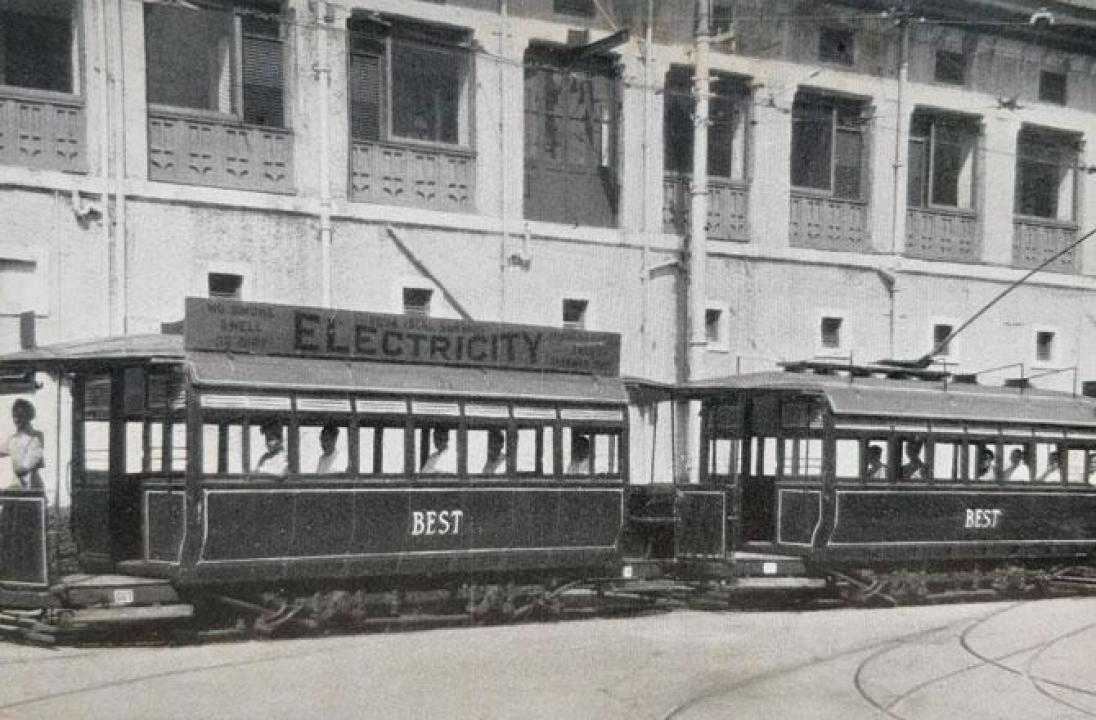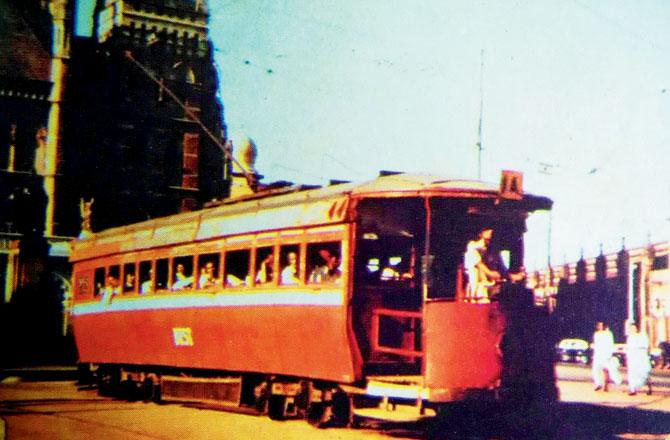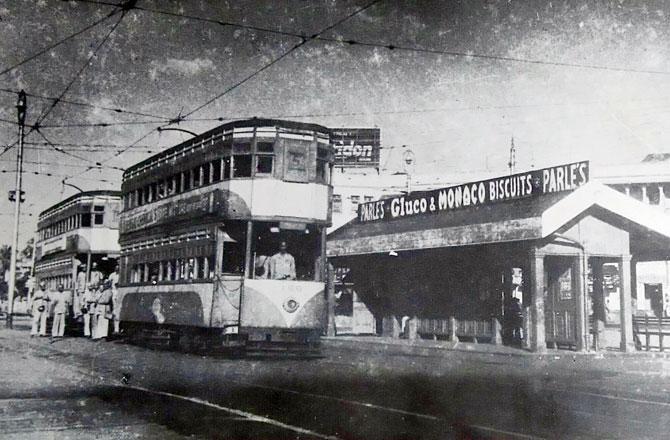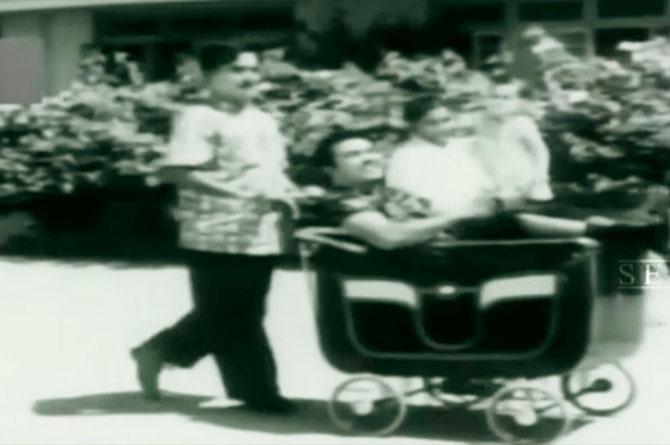In the festival of lights, we map how overhead-wired trams from early 20th-century Bombay changed the way the city travelled and lived

Two-compartment trailer trams started after 1910 to cope with rush hour. To the left of the word Electricity is printed: "No smoke, smell or dirt". Reproduced with permission from History of the Bombay Electric Supply & Tramways Company, Limited, by Pesto
 It-s November 3rd. On a day all of America burns with election fever, come exceptionally prompt mail reverts from Husein Nakhooda of Cleveland, drolly describing the tram ride to his grandfather-s home during childhood years in Bombay.
It-s November 3rd. On a day all of America burns with election fever, come exceptionally prompt mail reverts from Husein Nakhooda of Cleveland, drolly describing the tram ride to his grandfather-s home during childhood years in Bombay.
Slow-paced trams meant being transfixed by goings-on adults thought inappropriate for young eyes. He writes: "The first one is the one you remember. The journey from my Abdul Rehman Street home to Motapapa-s on Warden Road, involved the No. 13 tram to Tardeo or No. 16 to Gowalia Tank and connecting to a bus. That trip went through the infamous red-light district, -Pila House- in our vernacular. As we approached, Motapapa covered my eyes with his palm to ensure I would not avail of the sights. When I got old enough to travel on my own, Motapapa realised he had lost control."
ADVERTISEMENT
Nakhooda was also emboldened to try ingenious tricks from a second-floor bedroom. He tied a tiny pebble or empty cigarette packs on a string flung over the tram cable. "The weight attached on the cable. I swung it back and forth, pulling my end of the string. Till it disrupted the intended target, maybe a chanawala. Not funny now, but enjoyable pranks then."
Walking to St Xavier-s High School at Dhobi Talao, he and his buddies jumped onto rumbling trams with alacrity and audacity. They hung on by the rails until the conductor came to collect their fare. Leaping off, they repeated the process with the next passing tram.
From the same school, Rumi Taraporevala chuckles narrating naughty boy antics 80 years ago, while switching trams at Charni Road junction—"The conductor clanged that underfoot bell and I practised a little thuggery. Kids up to nine years paid half an anna 2 paise. Being small-built, I got away till finishing school at 16."
In the years preceding electrification, trams were unpopular in their horse-drawn avatar. The thrill of the novelty was naturally lost on cart drivers of simple "shigrams" and wobbly two-wheel "reklas". Protesting the threat to their occupation, they wedged dust and stone in grooves of rails. The clogging caused wheels to swerve off kilter on routes like Colaba-Pydhonie via Crawford Market and Bori Bunder-Pydhonie via Kalbadevi.
Following the 1873 formalisation of the Bombay Tramway Company Limited—the result of a contract between Bombay Tramway Company and the Municipality—the Government of Bombay enacted the Bombay Tramways Act, 1874, to licence the Company for services in the city. Messrs Stearns and Kittredge commenced operations with a limited number of trams pulled by horses draped in sun-protective hoods. Ponies tethered at the Wellington Mews presented a charming picture with scooped coconut shells covering the ears to cool their heads.

A single-compartment electric tram outside Victoria Terminus and the BMC Building tram station. Pic/BEST Archives
In 1899, the Company applied to the Municipality for permission to run tramcars on electricity. Freshly formed in 1905, Bombay Electric Supply and Tramways Company, Limited, bought Bombay Tramway Company. An interesting era of transport, of life itself, dawned.
"Bombayites gave a warm welcome to the electric tramcar," notes SN Pendsay, detailing the momentous May 7, 1907 event in The B.E.S.T. Story, translated to English by Prof MV Rajadhyaksha. "At five-thirty that afternoon, the first electric tramcar, specially decorated for the occasion, started outside the Municipal Office, went to Crawford Market and returned to the point it had left. After this ceremonious, inaugural run, four tramcars kept plying on various routes till eleven at night. People jostled to board them. The service started regularly from the next day. It drew nothing but praise: for its speed, its comfort and low fares."

Double decker electric tram, introduced in 1920, at Dadar TT. Still popular since 1932
An accident on day 1 entailed a Mr Malvankar fall from a moving tram. Trapped under-wheel, his leg was amputated. Despite setbacks, the network flourished. On an average, a commuter spent just 1 to 4 annas, depending on the distance. Administrative and design reforms prioritised stops being added and budgets that factored in better braking systems. A hand-held, steel dial machine recorded tickets issued, tallying cash documented with amounts deposited. Some conductors misused the instrument, reverse dialling to pocket the difference.
To avoid electric traction effects on magnetic recordings, the Colaba magnetic observatory—one of the world-s longest running observatories since 1841—shifted to Alibag.

Joshi Budhakaka Mahim Halwawala welcomed patrons straight off the trams who walked into the shop for its signature halwa. Pics/BEST Archives & Ashish Raje
The fleet grew, with trailer and double deck trams absorbing passenger pressure which mounted with post-War population spikes. On August 7, 1947, the BMC acquired Bombay Electric Supply and Tramways Company, Limited. The T, substituted to stand for Transport instead of Tramways, renamed the organisation Bombay Electric Supply and Transport Undertaking. Of course, Bombay becoming Mumbai in 1995, the BEST acronym finally settled as Brihanmumbai Electric Supply and Transport.
The next week, August 15 exploded in unbridled jubilation. A Raghav Wadi resident at French Bridge says, "Governors and viceroys had always driven past us grandly over the bridge. On Independence Day we proudly rode trams brightly lit with red-blue-yellow bulbs. Across town from Opera House, we felt the city bursting with happy excitement."

Prominent tram signs advertised leading brands around the mid-20th century. Pic Courtesy/Yatin Pimpale, Asst. Foreman, BEST Museum, Anik Depot
Terminus crossroads were hotly sought spots for commercial establishments. An example is Joshi Budhakaka Mahim Halwawala at Khodadad Circle, or Dadar TT tram terminus. The mithai shop-s origin burrows back to 1829. Pleased with their favourite cook, Mauji Joshi, Mahim-s Portuguese rulers gave him a stall on Kapad Bazar Road. Six generations down, Kiran Joshi, in the 1932-opened branch at Empire Mahal, says, "Trams stopping exactly outside, patrons conveniently stepped in to buy our halwa of pulped wheat, ghee, sugar and saffron sprinkled with dry fruit. Even dying men craving a last taste are supposed to have ordered it."
Some daring travellers scoff, "Only good-for-nothing -lallus- climbed into stationary trams, we were sure to catch them running." They cursed trolley trams, on rubber wheels and not embedded rails, make an infernal racket at Gowalia Tank. Others deliberately slowed their cars, pretending to neither see nor hear trams behind.

Still from N Vakil-s 1959 film, Kya Yeh Bambai Hai. The song "Yeh Bambai shahar ka bada naam hai" was a paean to city specialties, including its trams
Ophthalmic surgeon, Dr Ashok Shroff relates a 1950s escapade with a corpulent classmate from Grant Medical College who offered him a lift near Crawford Market. A tram hit the Citroen-s front fender and dragged the piece ahead. "Abandoning the car, we chased the tram which had gained speed. Imagine us huffing, breathlessly shouting, -Bumper! My bumper!-"
With pets not permitted, animal lovers smuggled in pooches when they had to. "I prayed my Toby didn-t suddenly decide to woof from the gunny bag he was hidden in, on visits to the vet," shares Nawshir Khurody. His father Dara Khurody conceived Aarey Milk Colony and the concept of toned milk in his 1946--52 tenure as Milk Commissioner of Bombay—revolutionary contributions, which won him the 1963 Ramon Magsaysay Award.
Skirting the ban on pets was an occasional necessity. Blither mischief was as sportingly viewed, no prickles raised at gentle ribbing certain to be condemned with communal colour today. "We cracked silly Parsi jokes, Sikh jokes, Maharashtrian jokes. Good-humoured teasing was tolerated, without the slightest umbrage taken," Khurody says. "In seats arranged for passengers to face each other, you couldn-t help smiling spontaneously at strangers. You struck up conversations so freely. It was easy bonding."
The camaraderie often cemented over conversations around food and film. Living beside Grant Road Station, schoolteacher Rutty Manekshaw, travelled on trams to give tuitions. The nonagenarian says, "Cinemas like Novelty and Super were halts at which many got on or off. Gowalia Tank, where trams changed tracks, was called -Tram no tabelo-, the shed they parked in for the night. Tickets were really cheap, rupyo toh aapre jaanyoch nathi—we never knew what it was to pay a rupee." Her favourite feature onboard was the backrest of seats, adjustable forward or backward, in the direction of the tram-s movement.
"Once electrified in 1907, newer readymade models of trams had entered service," explains Rajendra B Aklekar, author and mid-day journalist who has researched the subject. "Given the crowding, Mumbai required more and more vehicles. Older ones too were refurbished. The shifting backrest template remained in refurbished models and continued to, at least in single-decker older models."
Sitting companionably spaced was bound to be cut short in a city straining at the seams. Peaked with traffic, Bombay needed mass transport hogging fewer street feet. "It gathered such a pace that the tramcar was out of step, out of date and faded out on the night of 31st March 1964," observes Pendsay in his book.
Almost prescient about the shutdown, filmmakers of the end-1950s nicely immortalised the tram in song. Three years after CID-s 1956 hit "Ae dil hai mushkil", came the lesser known but beautiful lilt of "Yeh Bambai shahar ka bada naam hai". Mohammed Rafi warmly warbled Noor Dewasi-s lyrics, set to music by Bipin Dutta for N Vakil-s Kya Yeh Bambai Hai.
As Pendsay concludes, "These modest, if rather noisy, vehicles had devotedly carried Bombayman up and down the city for 90 years. The last, packed to capacity, left Bori Bunder for Dadar at 10 that night. Crowds lined the route at that late hour to bid farewell to the much-loved, old-fashioned, transport of the common man. It was a sad farewell."
Author-publisher Meher Marfatia writes fortnightly on everything that makes her love Mumbai and adore Bombay. You can reach her at meher.marfatia@mid-day.com/www.meher
marfatia.com
Keep scrolling to read more news
Catch up on all the latest Mumbai news, crime news, current affairs, and a complete guide from food to things to do and events across Mumbai. Also download the new mid-day Android and iOS apps to get latest updates.
Mid-Day is now on Telegram. Click here to join our channel @middayinfomedialtd and stay updated with the latest news
 Subscribe today by clicking the link and stay updated with the latest news!" Click here!
Subscribe today by clicking the link and stay updated with the latest news!" Click here!








